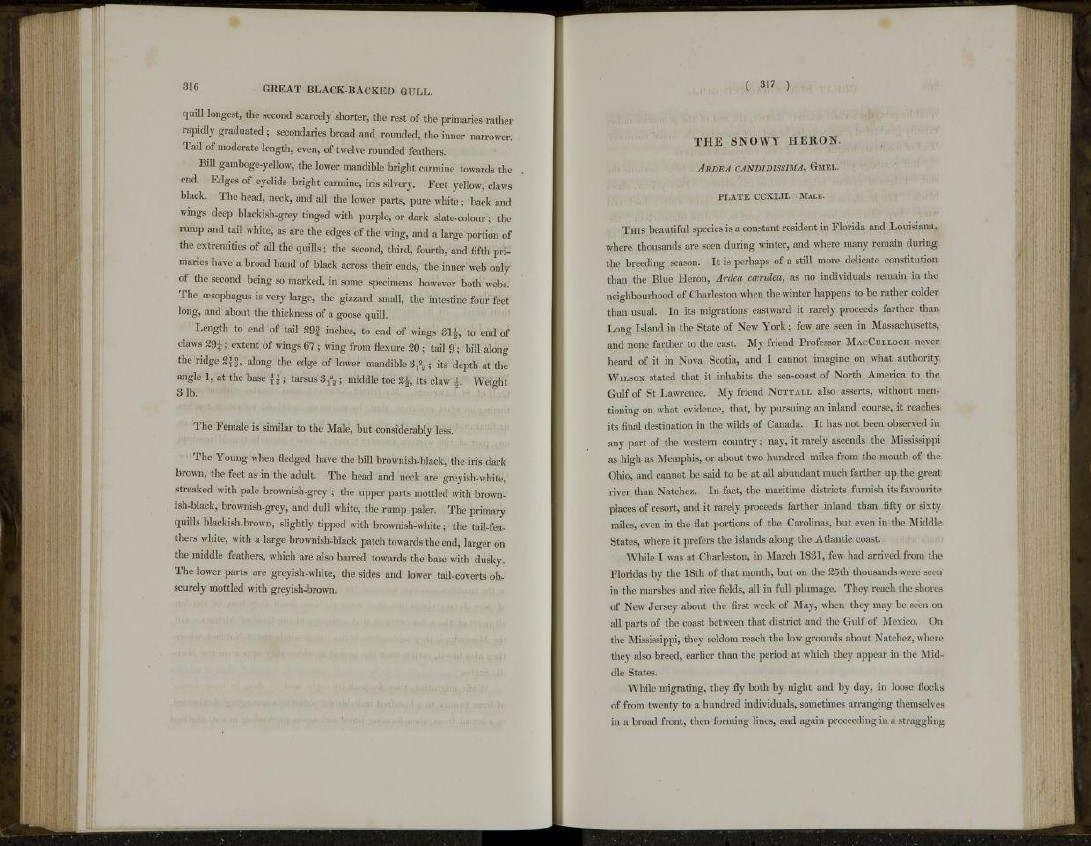
316 GREAT BLACK-BACKED GULL.
quill longest, the second scarcely shorter, the rest of the primaries rather
rapidly graduated ; secondaries broad and rounded, the inner narrower.
Tail of moderate length, even, of twelve rounded feathers.
Bill gamboge-yellow, the lower mandible bright carmine towards the .
end. Edges of eyelids bright carmine, iris silvery. Feet yellow, claws
black. The head, neck, and all the lower parts, pure white ; back and
wings deep blackish-grey tinged with purple, or dark slate-colour; the
rump and tail white, as are the edges of the wing, and a large portion of
the extremities of all the quills; the second, third, fourth, and fifth primaries
have a broad band of black across their ends, the inner web only
of the second being so marked, in some specimens however both webs.
The (esophagus is very large, the gizzard small, the intestine four feet
long, and about the thickness of a goose quill.
Length to end of tail 29f inches, to end of wings 31^, to end of
claws 29£; extent of wings 67 ; wing from flexure 20 ; tail 9; bill along
the ridge 2{£, along the edge of lower mandible 3 ^ ; its depth at the
angle 1, at the base { \ ; tarsus 3T
2^ ; middle toe 2^, its claw }2. Weight
3 1b.
The Female is similar to the Male, but considerably less.
The Young when fledged have the bill brownish-black, the iris dark
brown, the feet as in the adult. The head and neck are greyish-white,
streaked with pale brownish-grey ; the upper parts mottled with brownish
black, brownish-grey, and dull white, the rump paler. The primary
quills blackish-brown, slightly tipped with brownish-white; the tail-feathers
white, with a large brownish-black patch towards the end, larger on
the middle feathers, which are also barred towards the base with dusky.
The lower parts are greyish-white, the sides and lower tail-coverts oh»
scurely mottled with greyish-brown.
( 317 )
THE SNOWY HERON.
ARDEA CANDIDISS1MA, GMEL.
PLATE CCXLII. MALE.
THIS beautiful species is a constant resident in Florida and Louisiana,
where thousands are seen during winter, and where many remain during
the breeding season. It is perhaps of a still more delicate constitution
than the Blue Heron, Ardea ccerulea, as no individuals remain in the
neighbourhood of Charleston when the winter happens to be rather colder
than usual. In its migrations eastward it rarely proceeds farther than
Long Island in the State of New York; few are seen in Massachusetts,
and none farther to the east. My friend Professor MACCULLOCH never
heard of it in Nova Scotia, and I cannot imagine on what authority
WILSON stated that it inhabits the sea-coast of North America to the
Gulf of St Lawrence. My friend NCTTALL also asserts, without mentioning
on what evidence, that, by pursuing an inland course, it reaches
its final destination in the wilds of Canada. It has not been observed in
any part of the western country; nay, it rarely ascends the Mississippi
as high as Memphis, or about two hundred miles from the mouth of the
Ohio, and cannot be said to be at all abundant much farther up the great
river than Natchez. In fact, the maritime districts furnish its favourite
places of resort, and it rarely proceeds farther inland than fifty or sixty
miles, even in the flat portions of the Carolinas, but even in the Middle
States, where it prefers the islands along the Atlantic coast.
While I was at Charleston, in March 1831, few had arrived from the
Floridas by the 18th of that month, but on the 25th thousands were seen
in the marshes and rice fields, all in full plumage. They reach the shores
of New Jersey about the first week of May, when they may be seen on
all parts of the coast between that district and the Gulf of Mexico. On
the Mississippi, they seldom reach the low grounds about Natchez, where
they also breed, earlier than the period at which they appear in the Middle
States.
While migrating, they fly both by night and by day, in loose flocks
of from twenty to a hundred individuals, sometimes arranging themselves
in a broad front, then forming lines, and again proceeding in a straggling